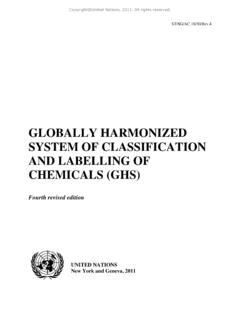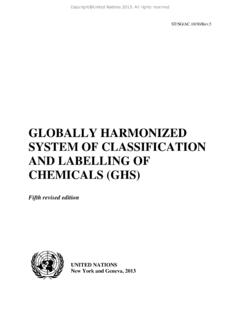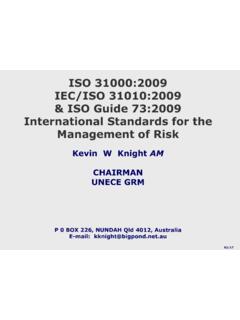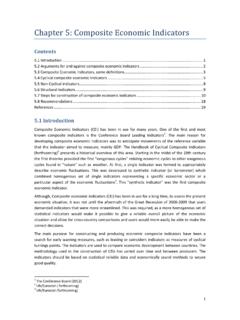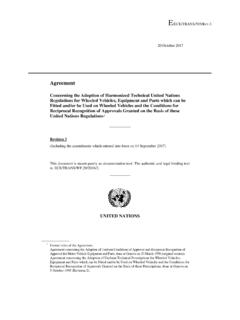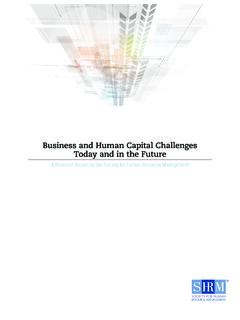Transcription of Human Resources Management and Training - UNECE
1 UNITED NATIONSH uman Resources Management and TrainingUNITED NATIONS ECONOMIC COMMISSION FOR EUROPEC ompilation of good practicesin statistical officesUNECE / FAOUNECE / FAOUNECE UNITED NATIONS Human Resources Management and TrainingHuman Resources Management and TrainingThis compilation provides 24 papers on good practices in Human Resources Management and Training in statistical offices from across the UNECE region, grouped into three sections: cross cutting issues, Training , and Human Resources Management . The papers cover a range of issues from recruitment and retaining of staff and setting up Training programs, to competence mapping and Management development.
2 The publication is available online at of good practicesin statistical offices UNITED NATIONS ECONOMIC COMMISSION FOR EUROPE Human Resources Management and Training Compilation of Good Practices in Statistical Offices United Nations New York and Geneva, 2013 NOTE The designations employed and the presentation of the material in this publication do not imply the expression of any opinion whatsoever on the part of the Secretariat of the United Nations concerning the legal status of any country, territory, city or area, or of its authorities, or concerning the delimitation of its frontier or boundaries. ECE/CES/28 iii PREFACE In an era of technological, social and economic change, statistical offices are facing several challenges to further develop their key role as provider of high-quality information on economic, social and environmental phenomena.
3 These include the need to meet both current and future demands of the users of statistics and to develop production processes that increase efficiency of work and reduce costs. New technologies and new organisational arrangements are fundamental in this respect. This is why the High-Level Group on Modernisation of Statistical Production and Services, established under the auspices of the Conference of European Statisticians, is developing an integrated approach to update production processes and statistical outputs. In this context, Human Resources are the most important asset of statistical offices. Appropriate and skilled Human Resources are essential to ensure the production of high quality statistics and to implement more efficient and effective production processes based on new technologies.
4 Proactive Human Resources Management is essential to achieve the abovementioned change and to allow statistical offices to meet the challenges today and in future. This volume includes 24 papers highlighting good practices in Human Resources Management and Training in statistical offices. The papers cover a range of issues from recruitment and retaining of qualified staff and setting up Training programmes, to competence mapping and Management development. These papers have been presented at seminars and workshops on Human Resources Management and Training from 2006 to 2012, organised on the initiative of the Conference of European Statisticians. It is my hope that the Compilation will be useful for the work on Human Resources in statistical offices in their transition to more efficient and effective working methods.
5 Mr. Enrico Giovannini Chairman of the Conference of European Statisticians v CONTENTS Note .. II Preface .. III Contents ..V Acknowledgements .. VII Cross cutting issues 1. Future Challenges in Human Resources Management and Training in National Statistical Offices .. 1 Wouter Jan van Muiswinkel, Statistics Netherlands 2. Strategic Personnel Planning .. 11 Wouter Jan van Muiswinkel, Statistics Netherlands 3. Strategy Based HR Management in Practice Experience of Statistics Finland .. 21 Hanna B rlund, Heli Jeskanen Sundstr m and Anna Leena Reinikainen, Statistics Finland 4. Statistical Excellence Through Capability Development and Planning .. 31 Chris Libreri, Australian Bureau of Statistics 5.
6 Managing Human Resources in a Small Statistical Office .. 39 Blagica Novkovska, State Statistical Office of the Republic of Macedonia Training 6. E learning System in STI, Statistics Korea: Achievements and Challenges .. 53 Kyung ae Park, Statistics Korea 7. Setting up In house Training : Some Issues to Consider .. 65 Dag Roll Hansen, Statistics Norway 8. Training Programme in Statistical Skills .. 85 Riikka M kinen, Statistics Finland 9. Theory and Practice in the Comprehensive Training Programme .. 101 Imre Dobossy, Eszter Viragh and Gabor Apati, Hungarian Central Statistical Office 10. Towards a European Master in Official Statistics .. 109 Anne Kofoed, Marius Suciu and Marcus Zwick, EUROSTAT 11.
7 Moving from Introduction Towards Integration of New Employees Objectives and Methods .. 117 Ingvild Maanum M ller, Statistics Norway 12. Management Development .. 125 Martin Lagerstr m, Statistics Sweden 13. From Competences to Awareness: Management Development .. 139 Antonio Ottaiano, Federica Navarra, Cecilia Colasanti and Fabrizio Rotundi, National Institute of Statistics of Italy 14. ABS Leadership and Management Charter and the Senior Executive Program .. 163 Chris Libreri, Australian Bureau of Statistics vi Human Resources Menagement 15. Recruiting and retaining Qualified Staff at Statistics Finland .. 169 Elina P kk , Statistics Finland 16. Mobility and Knowledge Sharing .. 187 Marleen Verbruggen and Adrie Ykema, Statistics Netherlands 17.
8 Becoming an Attractive Employer for Future Employees: Some Experiences from Statistics Norway .. 197 Rita Braziunaite, Heidi Torstensen and Jan Byfuglien, Statistics Norway 18. Learning and Development in Challenging Times .. 207 Anne Kofoed and Mats Olsson, EUROSTAT 19. A Competence Profile for Staff Supporting the European Statistical System .. 215 Wesley Miles, UK National Statistician s Office Silvio Stoppoloni, National Institute of Statistics of Italy Alexandra Molcuti, National Institute of Statistics of Romania Veronika Radermacher, EUROSTAT Wouter Jan van Muiswinkel, Statistics Netherlands Yolanda Gomez, National Statistics Institute of Spain 20. Why and How to Improve Competence Descriptions and Evaluations in a Statistical Institute?
9 227 Jan Byfuglien and Beate Johnsen, Statistics Norway 21. Beyond Vocational Training Competence Management at Statistics Sweden.. 233 Crister Haglund, Statistics Sweden 22. Statistics Finland s Personnel Survey .. 241 Anne Lahdenper Seunavaara, Statistics Finland 23. The Improvement of HR Management by Using Lean .. 253 Jan Byfuglien, Heidi Torstensen and Anne Trolie, Statistics Norway 24. Methods and Main Results of Staff Migration Motivation Research .. 261 Eszter Viragh, Hungarian Central Statistical Office vii ACKNOWLEDGEMENTS In 2010, the Bureau of the Conference of European Statisticians (CES) agreed that a workshop on Human Resources Management and Training (HRMT) in statistical offices should be organised to take place in 2012.
10 The aim of this workshop was to discuss current and upcoming issues for HRMT in statistical offices, and follow-up on issues discussed at previous CES workshops on HRMT. Leading on from this, it was requested by the Bureau that concrete outputs directed towards the creation of a compilation of good practices in HRMT. At the HRMT workshop in Budapest in September 2012, the participants supported the initiative to produce a compilation of good practices and agreed it should be based on selected papers from the HRMT seminar at the CES plenary session in 2006 and the following HRMT workshops in 2008 (Skopje), 2010 (Geneva) and 2012 (Budapest).


